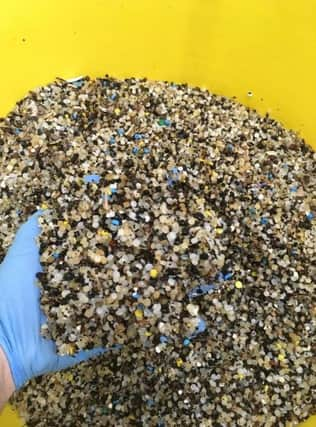Leader comment: The sinister beauty of plastic nurdles


It is feared that by the middle of this century there could be more plastic than fish in the sea. Now, it appears we are also heading towards a world where golden, sandy beaches are replaced by strange expanses of slowly degrading plastic pellets.
They may seem attractive given they come in a rainbow of colours, but they concentrate toxic chemicals in the environment.
Advertisement
Hide AdAdvertisement
Hide AdThey may seem harmless enough, given their tiny size, but that’s part of the problem. While larger pieces of plastic can choke marine wildlife to death or fill their stomachs so that they starve, they all eventually break down to the point where they can pass through the gut wall into blood vessels, becoming part of the food chain, part of the fabric of life itself. Eating seafood now carries the risk of ingesting tiny pieces of plastic that could then find their way inside you.
And plastic pollution may not appear to be a pressing problem – on a par with, say, Brexit or the cost of living – but as we focus on those ‘big issues’ the plastic keeps building up. As The Scotsman reports today, environmental charity Fidra found Ferrycraigs beach at North Queensferry had the UK’s highest concentration of plastic pellets known as “nurdles” – each about the size of a lentil – with nearly half a million discovered there during a national survey. That’s just a fraction of the billions of nurdles thought to enter the UK’s coastal waters every year and of the trillions of pieces of plastic estimated to be floating in the world’s oceans.
It is astonishing that we have managed to spread plastic to virtually every part of the ocean – from the depths of the Marianas Trench to the once-pristine waters of the Arctic – in less than the span of a human lifetime. But plastic has become such a key part of our lives that it is now difficult to go without the dreaded ‘single-use’ type – everything from straws to confectionary wrappers to cosmetics – and virtually impossible to avoid it altogether. READ MORE: Plastic pellets threaten to bury Scotland’s sandy beaches
That must change. We must now endeavour to gradually replace plastic with natural alternatives, ensure we recycle the plastic we continue to use, and stop flushing microplastics down the toilet. With support for such action across the political spectrum, it feels like the tide has finally turned but, make no mistake, there will still have to be some fairly fundamental changes in order for humanity to even begin to address this global problem.
